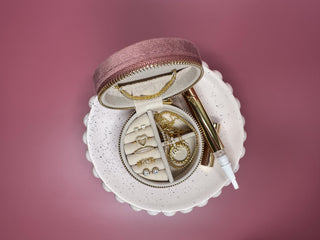Gold has been a symbol of luxury and prestige for centuries, adorning the powerful and the beautiful throughout history. When it comes to gold jewelry, you might have encountered terms like solid gold, vermeil gold, gold plated, and gold filled. In this blog post, we'll dive into the fascinating world of these different types of gold, shedding light on their unique characteristics, benefits, and how to choose the perfect piece for your style and budget.
Solid Gold: A Timeless Investment
Solid gold jewelry is the pinnacle of opulence. Crafted from pure gold, it is the most valuable and enduring choice. The purity of gold is measured in karats (kt), with 24kt being pure gold. However, pure gold is too soft for intricate designs, so jewelers alloy it with other metals like copper, silver, or zinc to enhance its durability and create different shades such as yellow, white, and rose gold. Solid gold pieces are cherished heirlooms, resistant to tarnishing and hypoallergenic, making them an investment in both style and value.
Vermeil Gold: A Touch of Elegance
Vermeil (pronounced vur-MAY) is a luxurious option that marries the warmth of gold with the affordability of silver. It involves a base of sterling silver that is coated with a thick layer of gold, typically 10kt or 14kt. Vermeil jewelry offers the allure of gold without the high cost. It boasts a rich hue, similar to solid gold, and is a popular choice for statement pieces or intricate designs where the delicacy of sterling silver meets the sophistication of gold.
Gold Plated: Affordable Glamour
Gold-plated jewelry is a budget-friendly option that brings a touch of glamour to your ensemble. Here, a thin layer of gold is electroplated onto a base metal like brass or copper. While gold-plated pieces are stylish and eye-catching, they may require more careful maintenance, as the gold layer can wear off over time due to factors like frequent wear and exposure to moisture and chemicals.
Gold Filled: Durability and Value
Gold-filled jewelry strikes a balance between quality and affordability. It involves a thicker layer of gold bonded to a base metal core, usually brass. The gold content in gold-filled jewelry is typically a higher percentage than in gold-plated pieces, making it more durable and resistant to tarnishing. Gold-filled jewelry can last for years with proper care, making it a great choice for everyday wear that doesn't compromise on elegance.
When selecting a type of gold jewelry, consider your personal style, budget, and preferences. Solid gold is a timeless investment, while vermeil offers an elegant touch at a lower price point. Gold-plated and gold-filled pieces provide affordable options for adding a dash of glamour to your collection.
The world of gold jewelry is as diverse as the shades it offers, with options to suit every taste and budget. From the opulence of solid gold to the affordability of gold-plated pieces, each type of gold jewelry brings its own unique allure. Whether you're seeking an heirloom-quality piece or a statement accessory, understanding the differences between solid gold, vermeil gold, gold plated, and gold filled will empower you to make informed choices that reflect your personal style and values.

Gold Plating vs. Gold Flashing
Gold plating is a process in which a thin layer of gold is deposited onto a base metal through electroplating. This involves immersing the base metal (usually brass or copper) in an electrolyte solution containing gold ions. An electrical current is then passed through the solution, causing the gold ions to adhere to the surface of the metal. The result is a layer of gold that is bonded to the base metal, creating a lustrous and attractive finish.
Benefits of Gold Plating:
- Aesthetic Appeal: Gold plating offers a genuine gold appearance, providing a luxurious and elegant look to the object.
- Durability: When done correctly, gold plating can be durable and resistant to tarnishing, depending on the thickness of the gold layer.
- Variety: Gold plating allows for a range of gold shades, from yellow and rose to white gold, depending on the type of gold used for plating.
- Affordability: Gold plating is often more affordable than solid gold, making it an accessible option for adding a touch of gold to items.
Gold flashing, also known as gold dipping or gold wash, is a similar process to gold plating, but with a thinner layer of gold applied. In this method, the base metal is immersed in a solution containing a minimal concentration of gold ions. The object is then quickly dipped, creating a very thin layer of gold on the surface. Gold flashing is often used for decorative purposes, such as enhancing the appearance of costume jewellery or accentuating small details on objects.
Benefits of Gold Flashing:
- Cost-Effective Enhancement: Gold flashing provides a cost-effective way to add a hint of gold to objects without the expense of a thicker gold layer.
- Subtle Elegance: The thin layer of gold from flashing can create a delicate and subtle enhancement, perfect for intricate designs.
- Versatility: Gold flashing is versatile and can be applied to various materials, making it suitable for a wide range of objects.
Whether you're seeking a lavish and enduring finish through gold plating or a delicate enhancement with gold flashing, understanding the differences between these processes empowers you to make informed choices that align with your vision, budget, and desired aesthetic.


















